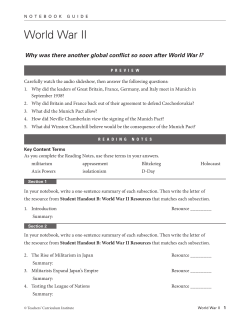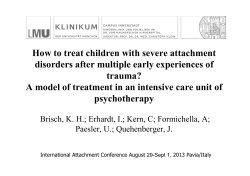
Blinded Sample Size Reestimation Tim Friede Warwick Medical School The University of Warwick
Blinded Sample Size Reestimation Tim Friede Warwick Medical School The University of Warwick This talk involves joint work with Meinhard Kieser, University of Heidelberg ELN Workshop, Munich, 30-31 October 2008 1 Outline • background and motivating examples • designs with sample size re-estimation • internal pilot study designs – blinded vs. unblinded sample size reviews – normal and binary outcomes – superiority and non-inferiority • further issues and conclusions ELN Workshop, Munich, 30-31 October 2008 2 Background • adequate sample sizes - why? – ethics, budget, and time – power for testing, precision for estimation • uncertainty in planning → high risk of inadequate sample sizes • solution: mid-course re-estimation of sample size ELN Workshop, Munich, 30-31 October 2008 3 Example: St John’s Wort in Depression • objective: to assess the efficacy and safety of St John’s wort in mild to moderate depression • design: randomised, double-blind, placebo-controlled • endpoint: change in HAMD from baseline to day 42 • initial sample size estimate: 128(= 2 × 64) patients – power 1 − β = 0.80, relevant difference ∆⋆ = 4, SD σ0 = 8 ELN Workshop, Munich, 30-31 October 2008 4 Example: St John’s Wort in Depression (cont.) • uncertainty in the planning phase – SD of HAMD at end of therapy 4-14.5 (Linde & Mulrow 2000) – placebo effect: very variable in depression • design: two-stage Bauer/K¨ ohne design (IA with 60 patients) – sample size reestimation to address uncertainty regarding SD – early stopping to address variability regarding placebo effect ELN Workshop, Munich, 30-31 October 2008 5 Example: St John’s Wort in Depression (cont.) Power=0.80 ELN Workshop, Munich, 30-31 October 2008 n=128 6 Designs with Sample Size Re-estimation • interim analysis – estimation of treatment effect – hypothesis test (offers opportunity for early stopping) – basically two types ∗ classical group sequential designs (e.g. Jennison & Turnbull 1999) ∗ designs based on combination of p-values (e.g. Bauer & K¨ ohne 1994) – sample size re-estimation could be based on observed treatment effect • sample size review – estimation of nuisance parameters (e.g. variance), no hypothesis test – design with internal pilot study (e.g. Wittes & Brittain 1990) ELN Workshop, Munich, 30-31 October 2008 7 Internal Pilot Study Design (Wittes & Brittain 1990) • initial sample size estimation n0 = n(α, 1 − β, ∆⋆ , σ ˆ02) – significance level α, desired power 1 − β, clinically relevant effect ∆⋆ – initial estimate σ ˆ02 of the nuisance parameter σ 2 (from other studies) • sample size review: – after recruitment of n1 = πn0 patients (e.g., π = 1/2) – estimation of nuisance parameter → σ ˆ2 ˆ = n(α, 1 − β, ∆⋆, σ – sample size re-estimation N ˆ2 ) ˆ ) − n1 ∗ ”restricted”: n2 = max(n0, N ˆ ) − n1 (Birkett & Day 1994) ∗ ”unrestricted”: n2 = max(n1 , N • final analysis – estimation of treatment effect and hypothesis test – with all n1 + n2 patients ELN Workshop, Munich, 30-31 October 2008 8 Sample Size Re-estimation and International Guidelines • ICH Guideline E9 (1998), Section 4.4 Sample size adjustment: The steps taken to preserve blindness and consequences, if any, for the type I error [. . . ] should be explained. • CHMP Reflection Paper on Adaptive Designs (2007), Section 4.2.2 Sample size reassessment: Whenever possible, methods for blinded sample size reassessment [. . . ] that properly control the type I error should be used. • requirements: blinding and control of type I error rate ELN Workshop, Munich, 30-31 October 2008 9 Continuous Data: t-Test • data: normally distributed with equal within-group variances σ 2 • hypotheses: H0 : µT ≤ µC vs. H1 : µT > µC (Φ−1(α) + Φ−1(β))2 2 σ • approximate sample size: N = 4 ⋆2 ∆ • sample size adjustment – re-estimating σ 2 by S 2 = n 1−2 1 P ¯i )2 i,j (Xij − X – partial unblinding!, requires Independent Data Monitoring Committee (IDMC) ELN Workshop, Munich, 30-31 October 2008 10 Unblinded Re-estimation: Actual Type I Error Rate: Results • nominal level α = 0.025 • unrestricted design • actual type I error rate αact depending on – size of the internal pilot study n1 – required, but unknown sample size N 0.034 0.032 0.030 0.028 0.026 50 50 100 100 n1 150 • reference: Kieser & Friede (2000) ELN Workshop, Munich, 30-31 October 2008 150 200 N 200 11 αact Unblinded Re-estimation: Control of Type I Error Rate • search for adjusted level αadj that fulfills max αact(αadj , n1, N ) ≤ α N • table below gives αadj for α = 0.025 and unrestricted design • slightly conservative, but adjusted level reasonably close to nominal level for say n1 ≥ 50 n1 αadj 10 0.0178 20 0.0210 30 0.0223 ELN Workshop, Munich, 30-31 October 2008 50 0.0233 100 0.0241 180 0.0245 12 Alternative Approach for Type I Error Rate Control • cause of type I error rate inflation: biased variance estimator (variance underestimated) • idea: add correction term to variance (in test statistic) • result: acutal level close to nominal level • reference: Miller (2005) ELN Workshop, Munich, 30-31 October 2008 13 Example: St John’s wort in patients with depression • interim analysis with 65 patients (31 St John’s wort, 34 placebo) ˆ = 4.9, s1 = 5.8 → p1 < 0.001 – ∆ – early rejection of null hypothesis • sample size review – imagine: same study as above, but with IPS – s1 = 5.8 → n = 68 (unrestricted), n = 128 (restricted) ELN Workshop, Munich, 30-31 October 2008 14 Variance Estimators for Blinded Sample Size Reviews • idea: total variance = within-group + between-group variance P 1 2 ¯ 2 • one-sample variance SOS = n −1 i,j (Xij − X) 1 – in typical clinical trials, between-group variance relatively small compared to within-group variance • adjusted one-sample variance (Zucker et al. 1999) 2 unbiased under alternative ∆ = ∆⋆ – idea: Sadj 2 2 − = SOS – Sadj 1 n1 ∆⋆2 4 n1 − 1 ELN Workshop, Munich, 30-31 October 2008 15 Blinded Sample Size Adjustment Actual Type I Error Rate adjusted variance S2adj one-sample variance S2OS Situation α = 0.025 α = 0.05 αact − α Min Max -0.0001 0.0001 -0.0001 0.0001 α 1−β 0.025 0.80 0.90 0.80 0.90 0.05 αact − α Min Max -0.0001 0.0001 -0.0001 0.0001 -0.0001 0.0002 -0.0001 0.0001 • situations considered: N = 20, 40, . . . , 200, n1 = 20, 30, . . . , 100 • conclusion: no relevant excess of the nominal level observed! ELN Workshop, Munich, 30-31 October 2008 16 Power of Blinded Sample Size Adjustment Procedures 1 − β = 0.80, α = 0.025 ∆/σ N n1 0.7 64 0.5 126 0.3 348 40 60 40 60 80 120 40 60 100 150 250 350 OS variance Power E(n) 0.800 72.1 0.816 73.1 0.792 134.1 0.797 134.0 0.800 134.0 0.811 135.8 0.787 356.1 0.792 356.0 0.796 355.9 0.799 355.9 0.800 355.9 0.812 363.9 ELN Workshop, Munich, 30-31 October 2008 Adjusted variance Power E(n) 0.752 64.3 0.790 67.4 0.765 126.0 0.771 126.0 0.775 126.0 0.797 130.2 0.777 348.0 0.783 348.0 0.787 348.0 0.790 348.0 0.791 348.0 0.808 359.8 17 Example: St John’s wort in depression • imagine: study as above, but with blinded sample size review • initial sample size estimate: 128 patients (σ0 = 8) • blinded sample size review: – with 65 patients (31 St John’s wort, 34 placebo) – sOS = 6.3 → n = 80 – sadj = 6.0 → n = 74 ELN Workshop, Munich, 30-31 October 2008 18 Example: St John’s wort in depression ELN Workshop, Munich, 30-31 October 2008 19 Discussion: Unblinded Review vs. Blinded Review • unblinded estimate of within-group variance always smaller than estimate of total variance • blinded review has good power and sample size properties • blinded review carried out by trial statistician and clinical trial leader, no IDMC necessary • unblinded reviews potentially reveal information on effect size • regulators seem to favour blinded reviews ELN Workshop, Munich, 30-31 October 2008 20 Blinded Sample Size Reviews in Non-inferiority Trials • treatments similar: blinded review even more attractive 0.053 • Type I error rate: small inflation observed ! • difference vs. ratio of two means 0.052 0.051αact 0.05 20 50 40 n1 100 60 150 80 • equivalence trials: two onesided tests • ref.: Friede & Kieser (2003) ELN Workshop, Munich, 30-31 October 2008 100 N 200 Std. non-inf. margin D/σ = −0.3 21 Blinded Sample Size Reviews with Binary Outcomes • update information on overall event rate (Gould 1995) • treatment effect: risk difference, relative risk, or odds ratio – re-estimation very sensitive to choice – risk difference considered here (Friede & Kieser 2004) • type I error rate: similar to χ2 test in fixed sample size design • power: good power in balanced designs, careful with very imbalanced designs ELN Workshop, Munich, 30-31 October 2008 22 BSSR with Binary Data: Power (Friede & Kieser 2004) =1 =3 Power 0.90 Power 0.90 0.88 0.88 0.86 0.86 0.84 0.84 0.82 0.82 0.80 0.80 PSfrag replaements 0.78 PSfrag replaements 0.78 0.76 0.76 at n1 0.74 n1 = 100 n1 = 200 n1 = 300 at n1 0.72 0.74 0.72 0.70 0.70 0.68 0.68 0.0 0.1 0.2 xed n1 = 80 0.4 n1 0.3 1 = 0.5 100 n1 = 40 n1 = 200 n1 = 120 n1 = 300 0.0 0.1 0.2 0.3 xed 0.4 0.5 1 n1 = 80 0.6 0.7 0.8 0.9 n1 = 40 n1 = 120 α = 0.05, 1 − β = 0.80, ∆ = ∆⋆ = 0.2 ELN Workshop, Munich, 30-31 October 2008 23 BSSR with Ordinal Data (Bolland et al, 1998) • analysis: proportional odds model (Wilcoxon rank sum test) • nuisance parameters: overall probabilities for each category of ordinal outcome • BSSR: estimation of nuisance parameters does not require unblinding • example: head injury trial with Glasgow Outcome Scale (reduced to the three categories: good recovery; moderate disability; severe disability – dead) at 6 months as primary outcome ELN Workshop, Munich, 30-31 October 2008 24 BSSR with Time-to-Event Data (Whitehead 2001) • power depends on number of events • overall survival function can be estimated without unblinding • construct survival functions for treatment groups consistent with assumed treatment effect and observed overall survival • check whether trial is likely to produce number of events needed • considerations can include observed recruitment and wihtdrawal patterns ELN Workshop, Munich, 30-31 October 2008 25 Size of the Internal Pilot Study (n1) • n1 large enough to provide ”‘good”’ estimate • if it is planned to recruit at least nmin patients (e.g. to study safety), then n1 = nmin could be chosen • depends on follow-up time and recruitment rate • other strategies discussed in the literature (e.g. Denne & Jennison, 1999) ELN Workshop, Munich, 30-31 October 2008 26 Further Issues in Sample Size Reestimation • early readouts for sample size recalculation – problem: at IA only small proportion of patients completed follow-up – idea: use correlation between early and final readout and gain precision in estimation – references: Marschner & Becker (2001), W¨ ust & Kieser (2003, 2005) • use of confidence bounds rather than point estimates for sample size reestimation • GS procedure (Gould & Shih 1992) inappropriate (Friede & Kieser 2002; Letter to the Editor by Gould & Shih and reply; Waksman 2007) ELN Workshop, Munich, 30-31 October 2008 27 Conclusions • reasons other than sample size for interim look? – if yes, choose design with interim analyis – otherwise consider blinded sample size review • blinded sample size review – fulfils requirements according to ICH E9 – good power and sample size properties – . . . and it’s easy to apply! ELN Workshop, Munich, 30-31 October 2008 28 Further Reading • Chuang-Stein, C., Anderson, K., Gallo, P., Collins, S. (2006). Sample Size Reestimation: A Review and Recommendations. Drug Information Journal 40, 475–484. • Proschan, M. (2005). Two-stage sample size re-estimation based on a nuisance parameter: A review. Journal of Biopharmaceutical Statistics 15, 559–574. • Friede, T. and Kieser, M. (2006). Sample Size Recalculation in Internal Pilot Study Designs: A Review. Biometrical Journal 48, 537–555. ELN Workshop, Munich, 30-31 October 2008 29 References • Birkett MA, Day SJ (1994). Internal pilot studies for estimating sample size. Statistics in Medicine 13: 2455–2463. • Bolland K, Sooriyarachchi MR, Whitehead J (1998) Sample size review in a head injury trial with ordered categorical responses. Statistics in Medicine 17: 2835–2847. • Denne JS, Jennison C (1999) Estimating the sample size for a t-test using an internal pilot. Statistics in Medicine 18: 1575–1585. • Friede T, Kieser M (2002). On the inappropriateness of an EM algorithm based procedure for blinded sample size reestimation. Statistics in Medicine 21: 165–176. • Friede T, Kieser M (2003). Blind sample size reassessment in non-inferiority and equivalence trials. Statistics in Medicine 22, 995–1007. • Friede T, Kieser M (2004). Sample size recalculation for binary data in internal pilot study designs. Pharmaceutical Statistics 3: 269–279. • Gould AL (1995). Planning and revising the sample size for a trial. Statistics in Medicine 14: 1039-1051. • Gould AL, Shih (1992). Gould AL, Shih WJ. Sample size reestimation without unblinding for normally distributed outcomes with unknown variance. Communications in Statistics (A) 21(10):2833–2853. ELN Workshop, Munich, 30-31 October 2008 30 • Jennison C, Turnbull BW (1999). Group sequential methods with applications to clinical trials. Boca Raton, Chapman and Hall / CRC. • Kieser M, Friede T (2000). Re-calculating the sample size in internal pilot study designs with control of the type I error rate. Statistics in Medicine 19: 901–911. • Kieser M, Friede T (2003). Simple procedures for blinded sample size adjustment that do not affect the type I error rate. Statistics in Medicine 22: 3571–3581. • Marschner IC, Becker SL (2001). Interim monitoring of clinical trials based on long-term binary endpoints. Statistics in Medicine 20: 177–192. • Miller F (2005). Variance estimation in clinical studies with interimsample size reestimation. Biometrics 61: 355–361. • Linde K, Mulrow CD (2000) St John’s wort for depression (Cochrane Review). • Whitehead J (2001) Predicting the duration of sequential survival studies. Drug Information Journal 35: 1387–1400. • Waksman, J.A. (2007). Assessment of the Gould-Shih procedure for sample size re-estimation. Pharmaceutical Statistics 6: 53–65. • Wittes J, Brittain E (1990). The role of internal pilot studies in increasing the efficiency of clinical trials. Statistics in Medicine 9: 65–72. ELN Workshop, Munich, 30-31 October 2008 30 • W¨ ust K, Kieser M (2003) Blinded sample size recalculation for normally distributed outcomes using long- and short-term data. Biometrical Journal 45: 915–930. • W¨ ust K, Kieser M (2005) Including long- and short-term data in blinded sample size recalculation for binary endpoints. Computational Statistics & Data Analysis 48: 835–855. • Zucker DM, Wittes JT, Schabenberger O, Brittain E (1999). Internal pilot studies II: comparison of various procedures. Statistics in Medicine 18: 3493–3509. ELN Workshop, Munich, 30-31 October 2008 30
© Copyright 2025











